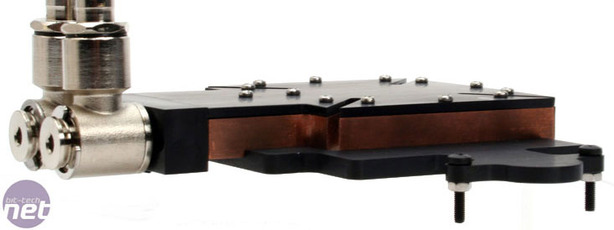BlastFlow Siberian Modular VGA Waterblock
September 1, 2007 | 04:34

BlastFlow is a company you will not have heard of before, but regular bit-tech readers will have heard of the man behind the name. That man is Vadim Chobanu, who is famed for his customised high-end PCs for those with deep pockets under the Vadim Computers brand.
Back in February, we had a look at Vadim’s Cepheus Q80, which weighed in at just shy of £5,000 and was not only fully watercooled, but was also one of the nicest looking pre-built PCs we've seen. Wait, scratch that, it is the nicest looking built-to-order PC we’ve seen!
Vadim is a man with tremendous attention to detail and the PCs built by his company show this off in full flow. The question is though, why would a system builder want to build its own VGA waterblock?
It’s a valid question and one that Vadim himself is best answering: “Everything started around November last year when we were waiting three weeks for a prepaid order of 8800 GTX waterblocks from a German company, and they couldn’t even deliver the full order so we had a refund instead. That’s why we made the decision to work on designing and making our own waterblocks.”
After months of development and refinement to his idea, we’re here today to preview Vadim’s first waterblock: the BlastFlow Siberian Modular VGA Waterblock. As you can probably guess from the name, the block is completely modular and will fit on a range of different graphics cards. This is something that was done in the past by many waterblock manufacturers, but not since graphics cards have required more than just the GPU cooled.

Today’s high-end graphics cards are power hungry beasts and require more than just the GPU and memory cooled and, as a matter of fact, this isn’t something that started with the Radeon HD 2900 XT or GeForce 8800 GTX. It’s been something that has been a requirement since Nvidia launched the GeForce 6800-series graphics cards back in 2004.
Since the GeForce 6800 launch which included the 6-pin power connector, the vast arrays of VRMs on today’s cards also need cooling. Without cooling, they would burn up quicker than you can say “gee, that’s hawt.” The heatsinks on these components have become progressively larger over the past few years and we’re now at the stage where the VRMs require some quite serious cooling.

This becomes a bigger problem because there isn’t one set of standards that all GPUs must adhere to. This is a big difference to CPU coolers, because there are certain standards set in stone that the cooler manufacturers have to take into account. To design a block that fit Vadim's requirements, he had to make one that can cool all of the card but doesn’t need a complete redesign every time a new graphics card is released. Of course, it also had to hold up to his rigorous standards.
Without further ado, let’s have a closer look at Vadim’s first entry into the complex yet fascinating world of watercooling...
Back in February, we had a look at Vadim’s Cepheus Q80, which weighed in at just shy of £5,000 and was not only fully watercooled, but was also one of the nicest looking pre-built PCs we've seen. Wait, scratch that, it is the nicest looking built-to-order PC we’ve seen!
Vadim is a man with tremendous attention to detail and the PCs built by his company show this off in full flow. The question is though, why would a system builder want to build its own VGA waterblock?
It’s a valid question and one that Vadim himself is best answering: “Everything started around November last year when we were waiting three weeks for a prepaid order of 8800 GTX waterblocks from a German company, and they couldn’t even deliver the full order so we had a refund instead. That’s why we made the decision to work on designing and making our own waterblocks.”
After months of development and refinement to his idea, we’re here today to preview Vadim’s first waterblock: the BlastFlow Siberian Modular VGA Waterblock. As you can probably guess from the name, the block is completely modular and will fit on a range of different graphics cards. This is something that was done in the past by many waterblock manufacturers, but not since graphics cards have required more than just the GPU cooled.

Today’s high-end graphics cards are power hungry beasts and require more than just the GPU and memory cooled and, as a matter of fact, this isn’t something that started with the Radeon HD 2900 XT or GeForce 8800 GTX. It’s been something that has been a requirement since Nvidia launched the GeForce 6800-series graphics cards back in 2004.
Since the GeForce 6800 launch which included the 6-pin power connector, the vast arrays of VRMs on today’s cards also need cooling. Without cooling, they would burn up quicker than you can say “gee, that’s hawt.” The heatsinks on these components have become progressively larger over the past few years and we’re now at the stage where the VRMs require some quite serious cooling.

This becomes a bigger problem because there isn’t one set of standards that all GPUs must adhere to. This is a big difference to CPU coolers, because there are certain standards set in stone that the cooler manufacturers have to take into account. To design a block that fit Vadim's requirements, he had to make one that can cool all of the card but doesn’t need a complete redesign every time a new graphics card is released. Of course, it also had to hold up to his rigorous standards.
Without further ado, let’s have a closer look at Vadim’s first entry into the complex yet fascinating world of watercooling...

MSI MPG Velox 100R Chassis Review
October 14 2021 | 15:04









Want to comment? Please log in.